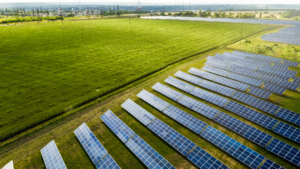
West Jordan is going through an energy dilemma. The city’s energy consumption has been increasing over the years, and the current sources of energy are not sustainable in the long run. The city council is now exploring alternative sources of energy that can cater to the energy needs of its residents while being environmentally responsible. In this blog, we will dive into the two major sources of energy – solar and fossil fuels – and evaluate their impact on West Jordan’s energy mix. We will also discuss the benefits and challenges of solar energy, its potential to meet West Jordan’s energy requirements, and compare its cost with fossil fuels. Lastly, we will analyze the environmental impact of both sources of energy and suggest policy reforms to promote solar energy in West Jordan.
Understanding Energy Consumption in West Jordan
Energy consumption patterns in West Jordan provide insights into the region’s economic growth, energy security risks, and opportunities for sustainable development. Analyzing this data can inform policymakers on effective energy policies and strategies that prioritize energy efficiency and renewable energy initiatives. By reducing dependence on fossil fuels, West Jordan can move towards a more sustainable energy landscape and make better decisions in the energy sector. Other countries, including China, the EU, India, Germany, and Russia, have also analyzed their energy consumption patterns to reach sustainability targets.
Current Energy Sources and their Impact
West Jordan’s energy mix encompasses a combination of various sources, including fossil fuels, renewables, and electricity imports. Fossil fuels currently dominate the energy supply in the region, contributing significantly to carbon emissions and climate change. However, it is important to note that renewable energy sources such as solar and wind play a relatively minor role in the energy mix.
While fossil fuels remain the primary source of energy in West Jordan, the increasing awareness of their adverse environmental impact has prompted discussions about diversifying energy sources. By reducing dependence on fossil fuels and incorporating more renewable energy options, West Jordan can enhance energy security and contribute to sustainability goals.
The Role of Fossil Fuels in West Jordan’s Energy Mix
Fossil fuels, such as natural gas and coal, play a significant role in powering West Jordan’s electricity generation. The region relies heavily on these fossil fuels, which can result in energy insecurity and price volatility. While fossil fuels have contributed to economic growth, they also pose environmental challenges. Transitioning away from fossil fuels is crucial for mitigating the impacts of climate change. By implementing clean energy policies, West Jordan can reduce its reliance on fossil fuels and decrease emissions.
It is important to address the dependency on fossil fuels in West Jordan’s energy mix. The high reliance on these non-renewable resources exposes the region to potential energy shortages and unpredictable market fluctuations. By diversifying their energy sources and incorporating more renewable options, West Jordan can enhance its energy security and stability.
The Cost Factor: Solar vs Fossil Fuels
Understanding the cost implications of energy sources is crucial for decision-making. Fossil fuels, despite their economic importance, face price volatility and supply insecurity. On the other hand, solar energy prices have decreased significantly, enhancing its competitiveness. This decrease in solar energy prices is a result of advancements in technology and economies of scale. As a result, investing in renewable energy, like solar, can provide long-term cost savings and energy security.
When evaluating the full lifecycle costs of fossil fuels, it is important to consider externalities such as environmental impacts. The extraction, processing, and burning of fossil fuels contribute to air pollution, climate change, and other environmental challenges. These costs are not fully reflected in the price of fossil fuels and are often borne by society as a whole. In contrast, solar energy production does not produce greenhouse gas emissions or contribute to air pollution, making it a more sustainable choice in terms of environmental impact.
A Comparative Analysis of Solar and Fossil Fuel Costs
Solar energy has become an increasingly cost-competitive alternative to fossil fuels in several regions, with some areas even seeing solar prices surpassing traditional fossil fuel sources. When analyzing the levelized cost of electricity (LCOE), we can clearly see the competitiveness of solar energy. But it’s important to consider the external costs associated with fossil fuels, such as carbon emissions and their impact on the environment. Incorporating these external costs into the equation changes the dynamics of cost comparison, making solar energy an even more compelling option. One of the key advantages of long-term investments in solar energy is its ability to offer more stable prices, which helps reduce the risk of price volatility and offers greater stability compared to fossil fuels, which are subject to fluctuations in supply and demand.
To further enhance the cost competitiveness of solar energy, there is a need for economic and policy support. Governments and organizations can play a crucial role in promoting solar energy adoption by providing incentives and implementing supportive policies. By creating a favorable environment, we can accelerate the transition towards sustainable and cost-effective power generation.
The Environmental Impact: Solar vs Fossil Fuels
Fossil fuels, such as coal, oil, and natural gas, have long been the dominant sources of energy for power generation. However, their use comes at a significant cost to the environment. Fossil fuels contribute to air pollution, climate change, and environmental degradation, making them unsustainable in the long run. On the other hand, solar energy offers a cleaner alternative with minimal carbon emissions.
The transition to solar energy can have a profound impact on mitigating climate change and preserving natural resources. Solar energy production does not release greenhouse gases like fossil fuels do, reducing the carbon footprint associated with power generation. This makes solar energy a crucial contributor to sustainable development and environmental goals.
Quantifying the Environmental Impact of Fossil Fuels
Fossil fuels have a significant environmental impact, contributing to carbon emissions that worsen climate change and leading to energy insecurity with heavy reliance on foreign imports and geopolitical considerations. Studies show negative effects on air, water, and soil quality due to the extraction process and harmful pollutants released during burning pose risks to human health. Quantifying the environmental impact of fossil fuels can guide policymakers towards more sustainable and environmentally friendly energy sources, such as solar energy.
Analyzing the Environmental Benefits of Solar Energy
Solar energy is a cleaner and more sustainable alternative to fossil fuels, providing a solution to West Jordan’s energy dilemma. Solar energy production does not contribute to air, water, or soil pollution, making it a much better option for the environment. When compared to fossil fuel extraction, solar energy has minimal environmental impact and does not harm natural ecosystems and habitats. Investing in solar energy also supports economic development and paves the way for a more sustainable future, creating new opportunities for economic growth. The global shift towards sustainability and the recognition of solar energy’s importance by international organizations such as the World Bank and the International Energy Agency (IEA) make it a viable solution for a more environmentally conscious world.

Policy Implications and Recommendations
West Jordan, like many other locations, faces an energy dilemma that requires careful policy considerations and recommendations. It is essential for West Jordan to prioritize the adoption of renewable energy sources, with a particular focus on solar power. By shifting towards solar energy, West Jordan can reduce its dependence on fossil fuels and promote a clean energy transition.
To facilitate this transition, government policies should provide incentives for the adoption of solar energy. This could include measures such as tax credits or feed-in tariffs, which would encourage individuals and businesses to invest in solar power generation. By incentivizing solar energy, West Jordan can not only reduce its carbon footprint but also stimulate economic development in the renewable energy sector.
Existing Energy Policies in West Jordan
West Jordan, like many other regions in the United States, has a major energy dilemma as it relies heavily on fossil fuels for electricity production. However, there is increasing awareness of the need for clean energy transition and sustainability. Many European countries, such as Germany, have already taken significant steps towards renewable energy sources, setting an example for others to follow. The United States has also signaled its commitment to reducing carbon emissions and adopting cleaner energy practices by rejoining the Paris Agreement in November 2021. Prioritizing renewable energy can lead to economic development and job creation, as studies have shown that solar power installations have the potential to create a substantial number of jobs in West Jordan and across the country.
The Road Ahead for West Jordan's Energy Landscape
West Jordan’s energy dilemma requires a transition towards a more sustainable energy mix. Renewable sources, such as solar power, should be prioritized in the city’s energy landscape. Continued policy reforms and investments are essential to achieve this transition, with a supportive regulatory framework for renewable energy projects. Public-private partnerships can drive innovation and investment in the solar sector, paving the way for a greener energy future. Education and awareness programs are vital in changing energy consumption patterns and promoting the adoption of renewable energy, encouraging residents and businesses to embrace clean energy options.
Conclusion
West Jordan faces a crucial energy dilemma between solar and fossil fuels. While fossil fuels have been the dominant source of energy, the environmental impact cannot be ignored. Solar energy offers numerous benefits, including clean and renewable power. However, there are challenges to consider, such as cost and potential for implementation. It is essential for West Jordan to evaluate the potential for solar energy and consider policy reforms to promote its adoption. The road ahead requires a careful analysis of existing energy policies and a strategic approach to transition towards a more sustainable energy landscape. By prioritizing renewable energy sources like solar, West Jordan can reduce its carbon footprint and create a cleaner and healthier environment for its residents.






